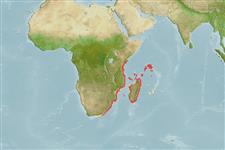Teleostei (teleosts) >
Scombriformes (Mackerels) >
Scombridae (Mackerels, tunas, bonitos) > Scombrinae
Etymology: Scomberomorus: Latin, scomber = mackerel + Greek, moros = silly, stupid (Ref. 45335).
Environment: milieu / climate zone / depth range / distribution range
Ecology
Marine; pelagic-neritic; oceanodromous (Ref. 51243); depth range 50 - 200 m. Subtropical; 1°S - 37°S, 23°E - 59°E (Ref. 168)
Western Indian Ocean: Seychelles, Kenya and Zanzibar to South Africa and along the west coast of Madagascar. This species has been confused with Scomberomorus lineolatus and with Scomberomorus guttatus (and also one of its junior synonyms Scomberomorus leopardus).
Length at first maturity / Size / Weight / Age
Maturity: Lm ?, range 80 - ? cm
Max length : 120 cm FL male/unsexed; (Ref. 168); max. published weight: 12.5 kg (Ref. 40637)
Dorsal spines (total): 15 - 17; Dorsal soft rays (total): 19 - 21; Anal soft rays: 19 - 22; Vertebrae: 45 - 46. Interpelvic process small and bifid. Body covered with small scales. Lateral line without auxiliary branches anteriorly, gradually curving down toward caudal peduncle. Intestine with 2 folds and 3 limbs. Juveniles have spots but develop adult pattern of interrupted lines by the time they reach 40 cm.
Neritic species (Ref. 5313). Forms large schools in the Zanzibar Channel from March to September. Feeds mainly on anchovies (Anchoviella sp.), clupeids (Amblygaster sp., Sardinella fimbriata, Sardinella perforata [= Sardinella albella), other small fishes, squids, and mantis shrimps.
Life cycle and mating behavior
Maturity | Reproduction | Spawning | Eggs | Fecundity | Larvae
Collette, B.B. and C.E. Nauen, 1983. FAO Species Catalogue. Vol. 2. Scombrids of the world. An annotated and illustrated catalogue of tunas, mackerels, bonitos and related species known to date. Rome: FAO. FAO Fish. Synop. 125(2):137 p. (Ref. 168)
IUCN Red List Status (Ref. 130435: Version 2024-2)
Threat to humans
Harmless
Human uses
Fisheries: commercial; gamefish: yes
Tools
Special reports
Download XML
Internet sources
Estimates based on models
Preferred temperature (Ref.
123201): 20.4 - 25.4, mean 21.8 °C (based on 19 cells).
Phylogenetic diversity index (Ref.
82804): PD
50 = 0.5000 [Uniqueness, from 0.5 = low to 2.0 = high].
Bayesian length-weight: a=0.00871 (0.00439 - 0.01729), b=3.02 (2.86 - 3.18), in cm total length, based on LWR estimates for this species & Genus-body shape (Ref.
93245).
Trophic level (Ref.
69278): 4.2 ±0.77 se; based on food items.
Generation time: 1.9 ( na - na) years. Estimated as median ln(3)/K based on 1
growth studies.
Resilience (Ref.
120179): Medium, minimum population doubling time 1.4 - 4.4 years (tm=2).
Fishing Vulnerability (Ref.
59153): Moderate vulnerability (39 of 100).
Nutrients (Ref.
124155): Calcium = 20.3 [8.9, 71.4] mg/100g; Iron = 0.893 [0.392, 2.210] mg/100g; Protein = 21.3 [20.0, 22.6] %; Omega3 = 0.411 [0.259, 0.665] g/100g; Selenium = 36.9 [13.0, 113.7] μg/100g; VitaminA = 9.34 [2.03, 46.45] μg/100g; Zinc = 0.419 [0.273, 0.700] mg/100g (wet weight);
